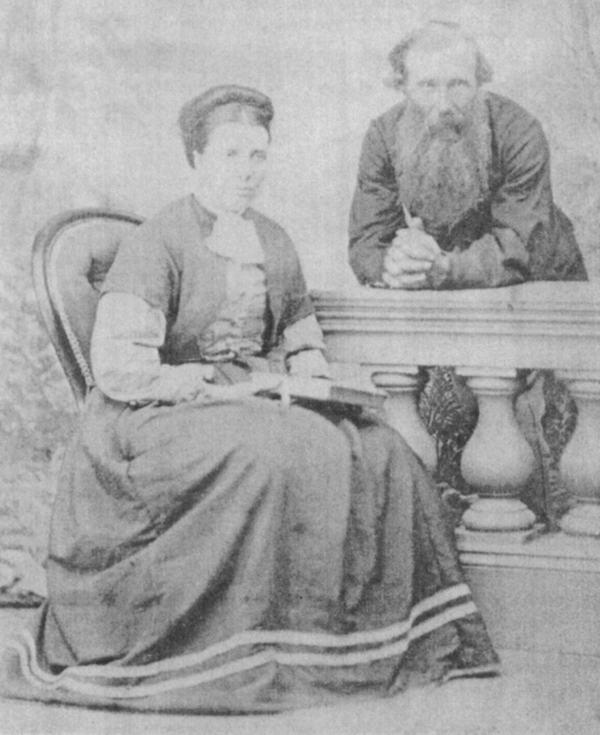

The Folk from the Wind Wound Isle > Generation B - Agnes Robertson
page 31
Born 1838 - Died 1918 - Married name McCUE

Agnes Robertson with her father Arthur Robertson
Agnes was the eldest of Margaret and Arthur's children and she was born at Scalloway, Shetland on 30 March 1838. Being the first-born girl she was named after her maternal grandmother Agnes Williamson. I have no stories about Agnes before she came to Australia.
Accompanied by her sister Margaret and brother Arthur, Agnes arrived in Australia in September 1867, after a journey of just under three months aboard the ‘John Temperly’. Agnes was twenty-nine years old and described on the shipping list as a knitter. John McCue tells us that Agnes provided a calming influence on the younger women she was travelling with when their ship was overtaken by a storm and the hatches battened down for several days. 1 After their arrival Agnes, Margaret and Arthur joined their parents at Derrinallum in the Victorian western district.
On 12 January 1870 Agnes married Michael Grace McCUE (1831?-1916) at Lake Tooliorook. The service was conducted by the Rev Edmund S Bickford, a Wesleyan Minister. Witnesses to the marriage were James and Arthur Robertson. Agnes and Michael had two sons and three daughters, Barbara (1871), Bean (1872), Arthur (1873), Aggie (1877) and Jack (1882). The family must have lived at Tooliorook for a time, as two of the three older children were born there. Later they took up land at Port Campbell where the two youngest children were born. It seems the marriage was not happy and Agnes is noticeably absent from family photos, which show Michael with some of his children. When their youngest
page 32
child was seven (about 1889), Agnes and Mick separated. Agnes and her eldest son, Arthur, lived at Smokey Point, while Mick lived with and cared for the other children in town, in a house on the corner of McCue and Lord Streets, Port Campbell.
The allotments shown are taken from an early Lands Department map and are referred to in the text.
page 33
Smokey Point, which is still a feature in the Port Campbell district, acquired its name from the Robertsons, according to Gus Ward. 2 Travelling by horseback to reach Port Campbell through the thick Heytesbury forest and coming out on the hill at Smokey Point gave the traveller a first sight of the ocean. It was customary to stop here for a rest and have a smoke before travelling down to the settlement.
We have lots of information and a lot of stories about Michael Grace McCue. The following account of his life has been put together from information supplied by his grand daughters, Marjorie Mathieson and Marion Parker, and other family members, as well as details gleaned from documents and rough notes left by John Collins McCue and supplied to me by John’s children, Jeff McCue and Helen Krigsman.
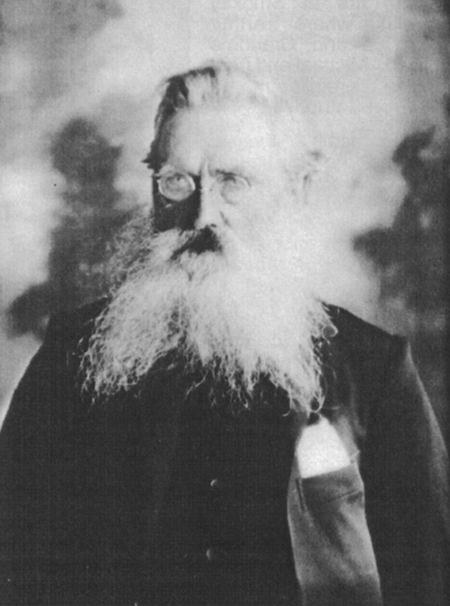 Mick was born at Ballinakill, Leix (pronounced Leash), Ireland, the illegitimate child of Margaret Grace. The date of his birth is uncertain but was possibly 29 September 1831. 3 On Mick's marriage certificate his mother’s name is recorded as Margaret Grace and his father's as John McCue, farmer. On his death certificate his mother is recorded as Margaret McCue nee McDonald and his father as John McCue, with place of birth as Queenstown, Clare. This is confusing. [Death certificates are notoriously inaccurate because the subject is not available to supply the appropriate information about themself!]
Mick was born at Ballinakill, Leix (pronounced Leash), Ireland, the illegitimate child of Margaret Grace. The date of his birth is uncertain but was possibly 29 September 1831. 3 On Mick's marriage certificate his mother’s name is recorded as Margaret Grace and his father's as John McCue, farmer. On his death certificate his mother is recorded as Margaret McCue nee McDonald and his father as John McCue, with place of birth as Queenstown, Clare. This is confusing. [Death certificates are notoriously inaccurate because the subject is not available to supply the appropriate information about themself!]
Michael Grace McCue >
When Mick was thirteen he went to sea as a cabin boy. He was in Waterford on 12 April 1849 when he enlisted in the British Army - 41st Welsh Regiment of Foot, whose headquarters at that time were in Cork, Ireland. His number was 2754 and he is described as being 5 feet 6 inches in height and aged 17 years and 9 months. Michael served in the Crimea War (1854-56) at Alma, Sevastopol and lnkerman and claimed to have seen the charge of the Light Brigade. We have the gruesome tale, handed down to his grandchildren, of him lying in wait for the enemy and chopping their heads off with a sword as they came through a narrow pass.
Michael was in lndia at the time of the mutiny in 1857. Other recorded postings included Cephalonia in Greece, 1851, Newcastle, 1861, and Sunderhead, June 1862. He carried the scars of two bullet wounds, one in his arm, the other where a bullet went through his nose and lodged in the roof of his mouth. He was granted a small pension - six pence for each wound, but the frequency of this rate is unknown. Both Marjorie and Jeff tell me there was a silver medal acknowledging the various campaigns Mick served in, but what has happened to this, no one seems to know.
Mick ended his army career in India and was discharged at Agra on 20 January 1867 - good conduct, 1 penny a day - having reached the rank of Quarter-Master Sergeant with his own batman to attend to him. From lndia, Mick migrated to Australia, arriving at Geelong, Victoria from Calcutta aboard the ‘Eldorado‘, on 30 March 1867. He is listed as British Army, aged 35 years. He was known at that time as Michael GRACE.
Marjorie Mathieson writes:
“He told my Dad [Mick's son, the Rev Jack McCue] he wrote to his ‘father and got permission to use [the] McCue name. We think his mother married John McCue (widower) the grandfather of the family. We were told a priest arranged a Michael Grace McCue marriage. Hearsay [claims] his biological
page 34

Cottage in Ireland
Where Michael McCue lived as a child.
father was English royalty. Marion visited the McCues in Ireland and they certainly knew of Michael and where his mother came from. Michael lived in a stone cottage that still stands on their farm. Kate put up a defensive wall against information and Marion was told he was a stray who came to the McCues in the potato famine. [There are] conflicting reports due to ‘shame’ of ‘no father’. My aunts had knowledge of his origins but kept secret. His mother disowned him when he married a protestant, however, Grandma McCue [Agnes] wrote to her when her children arrived and she wrote back. Letters destroyed in a fire at Smokey Point where Arthur McCue and Grandma lived. Michael and [the] other four children lived in Port Campbell. 4
Marjorie again, “Michael told Dad that his father John McCue was a very wild man who, when he had a disagreement with a neighbour, backed his horse into the neighbour’s door until it was kicked in.”
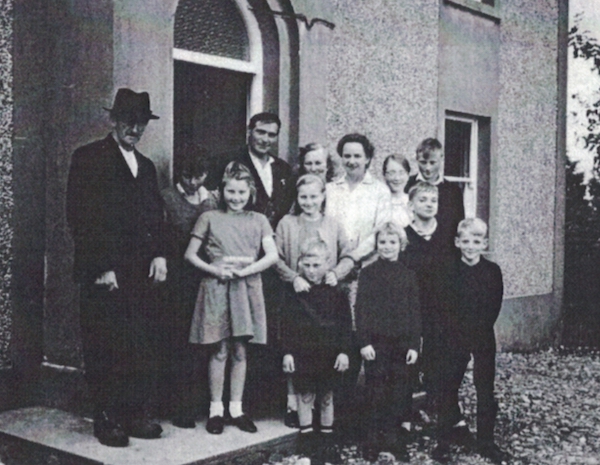
Parker Family and possible Irish relations
Left to right: Thomas McCue, son of Mick McCue‘s half brother. Thomas’ daughter and son in law Kate and Jack Hennessy and six of their eight children. Marion McCue Parker is in light colours and her three children are on her left in front, Marcia, Michael and John. Taken in Ireland in 1968.
Marion and Bill Parker and their three children visited the McCue farm at Ballinakill, Leix in September 1968. 5 There they met Thomas McCue, his daughter Kate McCue Hennessy, his son in law James Hennessy, and six of Kate's eight children. Thomas’ father (also called Thomas) was the half or stepbrother of Michael Grace McCue. During the visit Kate stressed that there was no blood relationship with her visitors. [Were they worried that Marion had come to claim an inheritance?] After Marion returned there was some follow up correspondence with the Irish McCues but this eventually petered out. 6
At Geelong it was customary for squatters to meet incoming boats so they could pick up workers, and this is how Mick found his way to Allen’s ‘Lang Currie’ station at Derrinallum. From there he
page 35
moved on to nearby Lake Keelunga Lara. He worked as a stonemason with the Robertson brothers, helping to build stone fences between Mortlake and Terang, west of Stoney Rises, and this is apparently how he got to know Agnes Robertson.
Hearing stories about Michael one cannot help but get the impression he was a cantankerous soul. One of his descendants described him as being ‘impossible to live with’. He drank heavily, which may have suited the Robertsons at the time they first knew him, but would not have fitted in with the squeaky clean image they presented after becoming evangelists. His other sins, in the eyes of the Robertsons, included being Irish and Catholic.
Michael is however, listed as a founding member of the Baptist Church at Port Campbell. Marion Parker tells the story of his baptism and conversion to his wife’s religion with Michael saying, ‘Ah Agnes l never meant to do this, l meant to make a Catholic out of you’. And Agnes’ response, ‘Ach Mick you’d never do that’. It seems the Robertsons later ‘kicked Michael out of the church’, because of his drinking and godless ways! Michael returned to the Catholic Church in his later life.
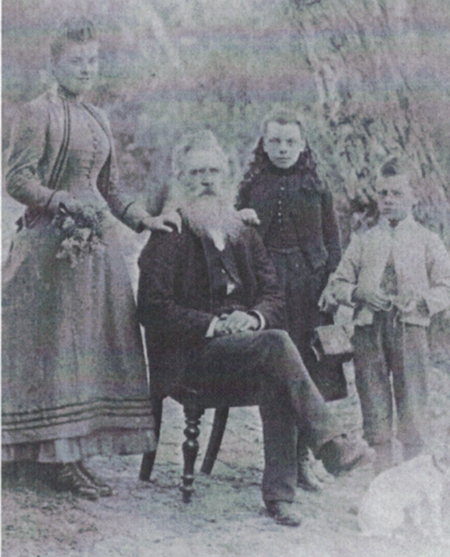
McCue Family >
Michael McCue with his children Robina, Agnes & John
We do not have as many stories about Agnes. She was musical and the possessor of a beautiful singing voice with a wide range. A photo of her in old age shows her wearing a coat and hat, firmly clutching a bag on her lap. I am told the photo was taken when she had been ill, so it would be unfair to judge her from this representation.
Barbara Rogers tells us, “Grandma McCue [Agnes] used to live at Port Campbell at Smokey Point in later years, with Uncle Arthur McCue until she went to live with Aunt Agnes Mott at Gama East where she passed away. Grandfather McCue [Michael] lived his last years with Barbara and Edwin Crouch at Panitya near Pinnaroo, SA. Nobody else would have him he was so obstreperous.” 7 Clive Crouch’s father told him that every Sunday Mick would put on his good clothes and go for a walk down the street at Panitya. It didn’t matter if the temperature was 105°F Mick would be dressed in suit, vest, tie and top coat, with hat and cane, and off he would go, giving his cane a twirl every few steps. 8
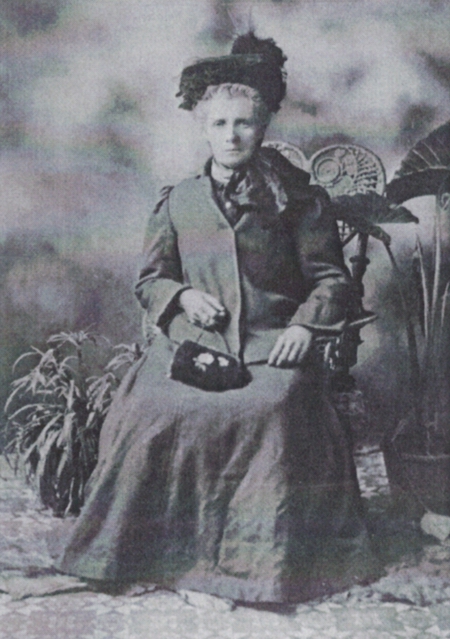 Agnes Robertson in her later years >
Agnes Robertson in her later years >
While living with the Crouchs, Barbara would only allow Michael an eggcup full of whisky each night. On one occasion however, he got on the grog and was making such a nuisance of himself, Barbara locked him out of the house. Mick kicked at the door shouting, ‘Let me in
page 36
Barbie, let me in’. Barbara sent one of the children to fetch Edwin from up the paddock to come and settle Mick down.
Michael died at Panitya at the beginning of 1916 and was buried at Murrayville by a Methodist minister! Barbara Rogers believes he died of gangrene after stubbing his toe. Agnes died, aged eighty-one years on 24 December 1919 and was buried on Christmas day in the Woomelang cemetery. There is a memorial to Agnes and Mick on the McCue grave at Port Campbell.
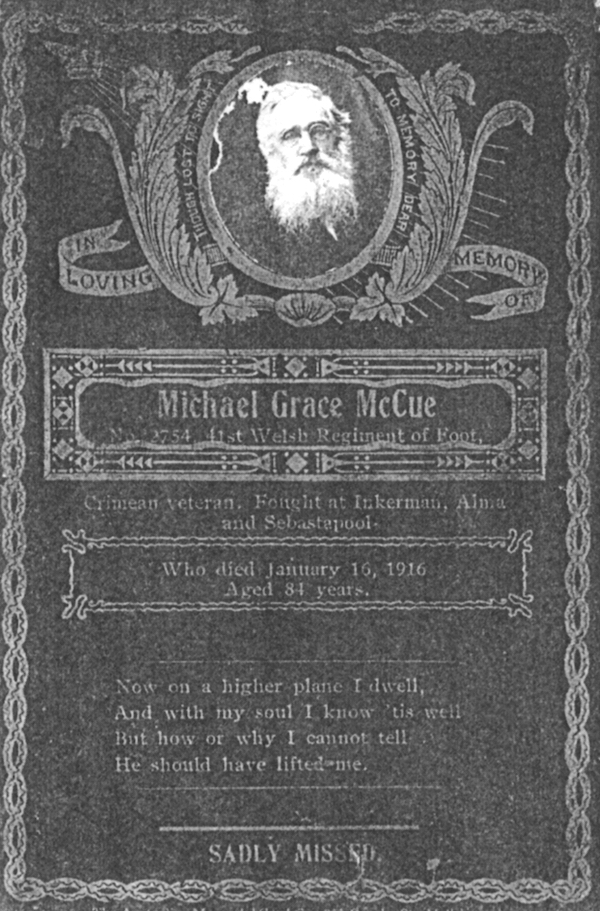
‘In Loving Memory Of’ Michael Grace McCue
1 John Collins McCue’s notes.
2 Interview with Gus Ward, April 2000
3 Documents are contradictory and in a letter Mareon Perkins, who is one of Agnes and Michael's great grandchildren, suggests the date is 1832, December 2000.
4 Letters from M. Mathieson, 1998/99
5 Telephone conversation notes with Marion Parker, 3.3.1999
6 Details about Michael’s Irish half-siblings are contained in Appendix 1
7 Letter from B. Rogers, 9.9.1999
8 Interview with Clive Crouch, April 2000
Appendix (not part of the book): documents and images relating to the military career of Michael Grace McCue
Garry Gillard | New: 13 March, 2019 | Now: 5 September, 2022